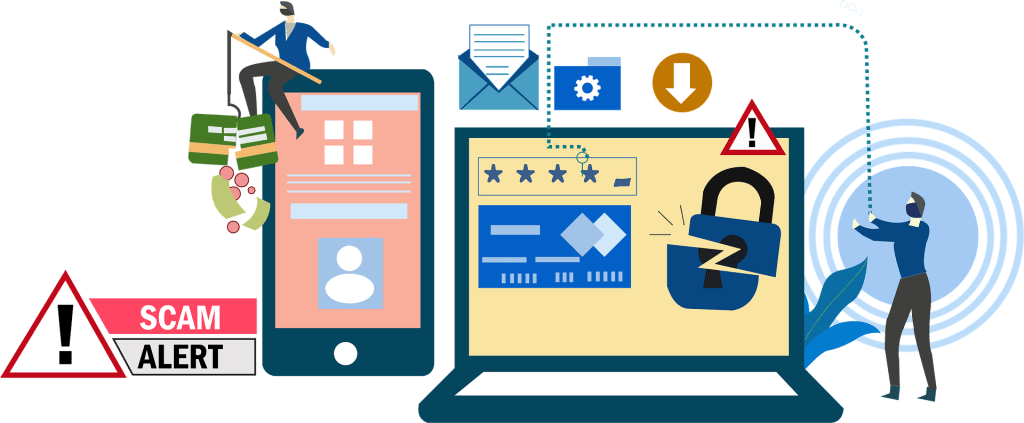

The increasing reliance on online shopping has raised significant concerns regarding its impact on our lives, as it offers convenience and an extensive array of products readily available with just a few clicks. The increasing popularity of e-commerce raises serious concerns about the heightened risk of individuals becoming victims of scams and fraudulent activities. The proliferation of fake online store scams is a grave concern, as cybercriminals employ deceitful tactics to exploit unsuspecting shoppers, resulting in financial loss and the compromise of personal information.
In this blog post, we will delve into the alarming tactics employed by scammers to fabricate deceptive online stores, and crucially, equip ourselves with the knowledge to effectively identify and thwart their malicious endeavors. It is of utmost importance to recognize the warning signs and proactively implement preventive measures in order to safeguard ourselves from becoming victims of deceitful online platforms. It is imperative that we thoroughly explore the realm of fraudulent online stores and equip ourselves with the necessary knowledge to ensure secure shopping experiences.
The fake online store scam is a sophisticated cybercrime wherein fraudsters set up e-commerce websites that mimic legitimate online stores. These fake websites look convincing and often offer products at incredibly low prices or promise exclusive deals to lure in unsuspecting shoppers. Their main goal is to deceive users into providing personal and financial information or steal money through fake transactions.

To avoid falling victim to fake online stores, follow these crucial steps when shopping online:
Jane, an avid online shopper, was on the lookout for a new smartphone. While browsing the internet, she came across a website offering the latest model at an unbelievably low price. The deal seemed too good to pass up, and the website appeared professional and genuine, complete with product images and customer reviews.
Excited about the seemingly fantastic offer, Jane quickly placed an order for the smartphone. The website accepted her credit card information for payment, but Jane noticed that there was no SSL encryption on the payment page. However, she brushed off this concern, as she was in a hurry to secure the discounted phone before it sold out.
Days passed, and Jane eagerly awaited her new smartphone’s arrival. But to her dismay, the package never arrived. When she tried to contact customer support through the email provided on the website, she received no response. She then attempted to call the phone number listed on the site, only to discover it was out of service.
Growing increasingly anxious, Jane decided to search for reviews on the website she had purchased from. To her horror, she found numerous complaints from other customers who had experienced the same fate – money taken, orders never delivered, and no way to reach the fake company.
Realizing she had fallen victim to a fake online store scam, Jane took immediate action. She contacted her bank to report the fraudulent transaction and canceled her credit card to prevent further unauthorized charges. However, the damage was done. Jane lost her hard-earned money, and her personal information may have been compromised.
Jane’s story serves as a stark reminder of the risks involved in online shopping and the importance of being vigilant. Scammers are constantly evolving their tactics to deceive unsuspecting shoppers like Jane, leaving them with financial losses and a sense of betrayal.
To protect ourselves from falling victim to fake online store scams, let’s reiterate the essential preventive measures:
By staying informed and practicing these precautions, we can minimize the risk of falling victim to fake online store scams and make our online shopping experiences safe and enjoyable. Remember, awareness is the best defense against cybercriminals, and a little skepticism can go a long way in safeguarding our hard-earned money and personal information.
As the e-commerce landscape expands, so do the risks associated with online shopping. The fake online store scam is a prevalent threat that can lead to financial losses and compromise personal information. By being vigilant and cautious, we can protect ourselves from falling victim to these deceptive websites.
When shopping online, always remember to verify the website’s authenticity, check for security protocols, and review customer feedback. Educating ourselves and staying informed about the tactics used by scammers are essential steps in safeguarding our online shopping experience.
Remember, if something seems too good to be true, it probably is. Stay alert, and trust your instincts when dealing with unfamiliar websites. By adopting these preventive measures, we can shop securely and confidently in the vast world of e-commerce.
Leave A Comment